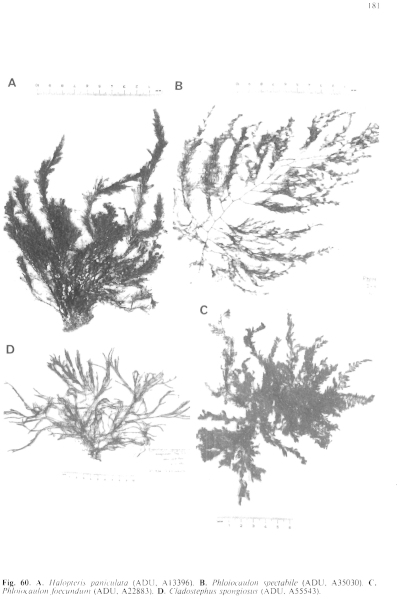|
|
|
|
|
|||||||||||
|
Electronic Flora of South Australia Species Fact Sheet
Phylum Phaeophyta – Order Sphacelariales – Family Cladostephaceae
Selected citations: Prud'homme van Reine 19726: 142. Sauvageau 1914: 581,602. figs 126–128.
Synonym
C. verticillatus (Lightfoot) C. Agardh 1817: xxvi. Sauvageau 1914: 488,601, figs 93–125. Womersley 1967: 206.
Thallus (Fig. 60D) medium brown, 5–20 µm long, with one to several repeatedly subdichotomous, linear axes 1–3 mm in diameter, from the crustose base. epilithic (rarely epiphytic). Branching of axes usually at moderate to long intervals, sometimes at short intervals. bearing closely packed and indistinct whorls of determinate laterals in shallow-water plants or distinct whorls in deeper-water plants; axes heavily corticated, denuded below, 300–500 µm in diameter. Determinate laterals (Fig. 62E) usually upwardly curved, ecorticate. at first simple but developing 1 to 3 laterals, often with axillary phaeophycean hairs, branched acroblastically. (500–) 600–1000 µm long, tapering basally and apically and 40–60 µm in diameter.
Reproduction: Reproduction by sporangia and gametangia borne on more or less straight and densely clustered ecorticate, usually simple, laterals 400–600 µm long and 18–24 (–30) µm in diameter with segments L/B 0.2–0.6 (–1.0), developed from outer cortical cells of older and mid parts of axes (mainly in winter), at first arising between the determinate laterals. Unilocular sporangia (not observed on Australian plants) with a 1–3 celled pedicel, ovoid. 55–80 µm long and 35–55 µm in diameter (Sauvageau 1914, p. 601): plurilocular gametangia (Fig. 62F.G) with a 1–6 celled pedicel, in groups of 1–3, ovoid to elongate ovoid, (25–) 30–60 µm long and 20–30 µm in diameter, with loculi 3–4 µm across.
Type from England; lectotype in BM.
Selected specimens: Cottesloe, Perth, W. Aust., drift (Levring, 16.vi.1948; ADU, A56279). Point Sinclair, S. Aust., drift ( Womersley, 25.i.1951; ADU, A13891). Port Noarlunga, S. Aust. (Harris, Aug. 1943; ADU, A1808). Baudin Rocks, Guichen Bay, S. Aust., 2–3 m deep (Shepherd, 15.ii.1975; ADU, A46103). Bridgewater Bay, Vic., upper sublittoral (Womersley, 15.v.1982; ADU, A55543). Taroona, Tas., 3–6 m deep (Shepherd. 19.iii.1975; ADU, A46281). Guerilla Bay, 14 km S of Batemans Bay, N.S.W., upper sublittoral (Barrett, 2.viii.1977; ADU, A48214). Keppell Bay, Qld (MEL, 15435).
Distribution: Widespread on temperate coasts of the North Atlantic and southern hemisphere. In Australia. from Yanchep, W. Aust., around southern Australia and Tasmania to Keppel Bay, Qld. Fertile from April to November.
Taxonomic notes: Prud'homme van Reine (1972b) has discussed the species of Cladostephus and regards most as forms of C. spongiosus. As in other countries, shallow water Cladostephus in southern Australia is usually the "spongiosus" form with obscure whorls of determinate laterals, whereas deeper water specimens are usually distinctly verticillate. The two forms recognised by Prud'homme van Reine as f. spongiosus and f. verticillata (Lightfoot) P. van Reine are ecologically based and doubtfully worth separating taxonomically.
References:
AGARDH, C.A. (1817). Synopsis Algarum Scandinaviae. (Lund.)
PRUD'HOMME VAN REINE, W.F. (1972b). Notes on Sphacelariales (Phaeophyceae) II. On the identity of Cladostephus setaceus Suhr and remarks on European Cladostephus. Blumea 20, 138–144.
WOMERSLEY, H.B.S. (1967). A critical survey of the marine algae of southern Australia. II. Phaeophyta. Aust. J. Bot. 15, 189–270.
The Marine Benthic Flora of Southern Australia Part II complete list of references.
Publication:
Womersley, H.B.S. (14 December, 1987)
The Marine Benthic Flora of Southern Australia
Part II
©Board of the Botanic Gardens and State Herbarium, Government of South Australia
Illustrations in Womersley Part II, 1997: FIGS 60D, 62 E–G.

Figure 60 enlarge
Fig. 60. A. Halopteris paniculata (ADU, A13396). B. Phloiocaulon spectabile (ADU, A35030). C. Phloiocaulon foecundum (ADU, A22883). D. Cladostephus spongiosus (ADU. A55543).

Figure 62 enlarge
Fig. 62. A–D. Phloiocaulon foecundum (A,B,D, ADU, A32326; C, ADU, A 15785). A. Upper branch system with indeterminate and determinate laterals and axillary phaeophycean hairs. B. Transverse section of old axis showing primary and secondary cortex. C. Longitudinal view of axis of sporangial plant. D. Axis of sexual plant with macro- and microgametangia. E–G. Cladostephus spongiosus (ADU, A55543). E. Longitudinal section of an axis showing upwardly curved determinate laterals and short simple, ecorticate laterals. F,G. Fertile laterals with plurilocular gametangia.

|
Email Contact: State Herbarium of South Australia |

|